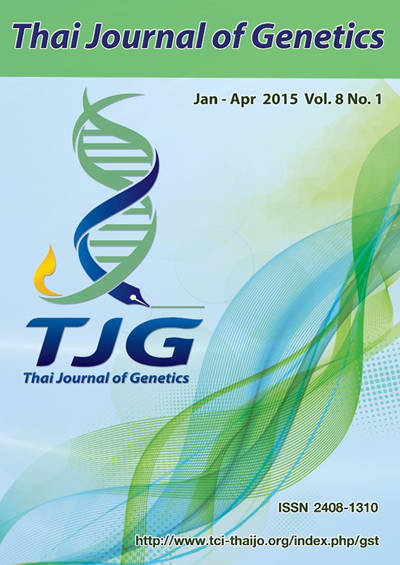Construction of thalassemic mouse induced pluripotent stem cells for disease modeling
DOI:
https://doi.org/10.14456/tjg.2015.4Keywords:
Induced pluripotent stem cells (iPSCs) have a great potential for disease modeling and therapeutic applications. One of the most common genetic diseases found in South East Asia is thalassemia. β-Thalassemia is an inherited single gene disorder caused byAbstract
Induced pluripotent stem cells (iPSCs) have a great potential for disease modeling and therapeutic applications. One of the most common genetic diseases found in South East Asia is thalassemia. β-Thalassemia is an inherited single gene disorder caused by reduction or absence of
β-globin chain production. The purpose of this study is to generate mouse iPSCs with β-thalassemia background. Mouse embryonic fibroblast (MEF) cells were obtained from transgenic β-thalassemic mouse, transduced with lentiviral vector carrying 4 transcription factors, Oct4, Klf4, Sox2 and c-Myc (OKSM), and cultured on a feeder layer. The embryonic stem (ES)-like colonies were manually picked up and expanded. The generated mouse iPSCs were similar to mouse embryonic stem cells (mESCs) in morphology, alkaline phosphatase activity and pattern of pluripotent gene expression and able to form teratoma containing tissues derived from all three germ layers. Therefore, we reported here an establishment of β-thalassemic mouse iPSCs which might be used for further disease modeling and therapeutic applications.
References
Cao A, Galanello R (2010) Beta-thalassemia. Genet Med 12: 61–76.
Cavazzana-Calvo M, Payen E, Negre O, Wang G, Hehir K, Fusil F, Down J, Denaro M, Brady T, Westerman K, et al. (2010) Transfusion independence and HMGA2 activation after gene therapy of human beta-thalassaemia. Nature 467: 318–322.
Chang CJ, Bouhassira EE (2012) Zinc-finger nuclease-mediated correction of alpha-thalassemia in iPS cells. Blood 120: 3906–3914.
Dimos JT, Rodolfa KT, Niakan KK, Weisenthal LM, Mitsumoto H, Chung W, Croft GF, Saphier G, Leibel R, Goland R, et al. (2008) Induced pluripotent stem cells generated from patients with ALS can be differentiated into motor neurons. Science 321: 1218–1221.
Dull T, Zufferey R, Kelly M, Mandel RJ, Nguyen M, Trono D,Naldini L (1998) A third-generation lentivirus vector with a conditional packaging system. J Virol 72: 8463–8471.
Glauche I, Herberg M, Roeder I (2010) Nanog variability and pluripotency regulation of embryonic stem cells-insights from a mathematical model analysis. PLoS One 5: e11238.
Lewis J, Yang B, Kim R, Sierakowska H, Kole R, Smithies O, Maeda N (1998) A common human beta globin splicing mutation modeled in mice. Blood 91: 2152–2156.
Papapetrou EP, Lee G, Malani N, Setty M, Riviere I, Tirunagari LM, Kadota K, Roth SL, Giardina P, Viale A, et al. (2011) Genomic safe harbors permit high beta-globin transgene expression in thalassemia induced pluripotent stem cells. Nat Biotechnol 29: 73–78.
Park IH, Arora N, Huo H, Maherali N, Ahfeldt T, Shimamura A, Lensch MW, Cowan C, Hochedlinger K, Daley GQ (2008) Disease-specific induced pluripotent stem cells. Cell 134: 877–886.
Rund D, Rachmilewitz E (2005) Beta-thalassemia. N Engl J Med 353: 1135–1146.
Sander JD, Joung JK (2014) CRISPR-Cas systems for editing, regulating and targeting genomes. Nat Biotechnol 32: 347–355.
Song B, Fan Y, He W, Zhu D, Niu X, Wang D, Ou Z, Luo M,Sun X (2015) Improved Hematopoietic Differentiation Efficiency of Gene-Corrected Beta-Thalassemia Induced Pluripotent Stem Cells by CRISPR/Cas9 System. Stem Cells Dev 24: 1053–1065.
Soldner F, Hockemeyer D, Beard C, Gao Q, Bell GW, Cook EG, Hargus G, Blak A, Cooper O, Mitalipova M, et al. (2009) Parkinson's disease patient-derived induced pluripotent stem cells free of viral reprogramming factors. Cell 136: 964–977.
Sun N, Zhao H (2013) Transcription activator-like effector nucleases (TALENs): a highly efficient and versatile tool for genome editing. Biotechnol Bioeng 110: 1811–1821.
Takahashi K, Tanabe K, Ohnuki M, Narita M, Ichisaka T, Tomoda K, Yamanaka S (2007) Induction of pluripotent stem cells from adult human fibroblasts by defined factors. Cell 131: 861–872.
Takahashi K, Yamanaka S (2006) Induction of pluripotent stem cells from mouse embryonic and adult fibroblast cultures by defined factors. Cell 126: 663–676.
Tubsuwan A, Abed S, Deichmann A, Kardel MD,Bartholomä C, Cheung A, Negre O, Kadri Z, Fucharoen S, von Kalle C, et al. (2013) Parallel assessment of globin lentiviral transfer in induced pluripotent stem cells and adult hematopoietic stem cells derived from the same transplanted β-thalassemia patient. STEM CELLS 31: 1785–1794.
Varela I, Karagiannidou A, Oikonomakis V, Tzetis M, Tzanoudaki M, Siapati EK, Vassilopoulos G, Graphakos S, Kanavakis E,Goussetis E (2014) Generation of human beta-thalassemia induced pluripotent cell lines by reprogramming of bone marrow-derived mesenchymal stromal cells using modified mRNA. Cell Reprogram 16: 447–455.
Warlich E, Kuehle J, Cantz T, Brugman MH, Maetzig T, Galla M, Filipczyk AA, Halle S, Klump H, Scholer HR, et al. (2011) Lentiviral vector design and imaging approaches to visualize the early stages of cellular reprogramming. Mol Ther 19: 782–789.
Xie F, Ye L, Chang JC, Beyer AI, Wang J, Muench MO, Kan YW (2014) Seamless gene correction of beta-thalassemia mutations in patient-specific iPSCs using CRISPR/Cas9 and piggyBac. Genome Res 24: 1526–1533.
Ye L, Chang JC, Lin C, Sun X, Yu J, Kan YW (2009a) Induced pluripotent stem cells offer new approach to therapy in thalassemia and sickle cell anemia and option in prenatal diagnosis in genetic diseases. Proc Natl Acad Sci U S A 106: 9826–9830.
Ye Z, Zhan H, Mali P, Dowey S, Williams DM, Jang YY, Dang CV, Spivak JL, Moliterno AR, Cheng L (2009b) Human-induced pluripotent stem cells from blood cells of healthy donors and patients with acquired blood disorders. Blood 114: 5473–5480.
Yu J, Vodyanik MA, Smuga-Otto K, Antosiewicz-Bourget J, Frane JL, Tian S, Nie J, Jonsdottir GA, Ruotti V, Stewart R, et al. (2007) Induced pluripotent stem cell lines derived from human somatic cells. Science 318: 1917–1920.



